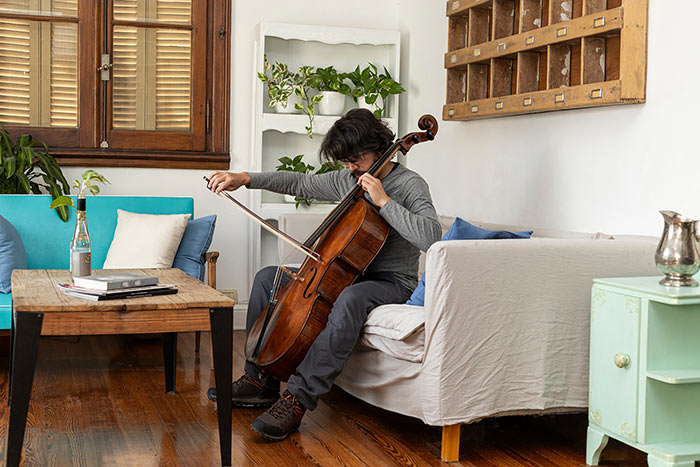Mastering the cello, like any musical instrument, requires consistent and focused practise.
However, simply spending hours playing scales and pieces does not guarantee progress.
To truly improve, it is essential to approach practise time with strategy, mindfulness, and clear goals.
Efficient cello practise means making the most out of every minute, using targeted exercises, developing technique, and nurturing musicality.
Whether you’re a beginner or an advanced player, the following strategies will help you make the most of your practise time and accelerate your growth as a cellist.
Set Clear, Achievable Goals
Before beginning any practise session, it is crucial to define what you want to achieve. Setting specific goals helps you stay focused and ensures that your practise is purposeful.
Vague objectives like “practise for an hour” are far less effective than setting clear, measurable goals such as “improve intonation in the first movement of my piece” or “perfect the bowing pattern in a specific passage.”
Your goals should be both long-term and short-term. Long-term goals might include mastering a difficult piece, improving overall bow control, or preparing for a performance.
Short-term goals, on the other hand, focus on incremental progress, such as learning a specific section of a piece or increasing speed in a particular passage.
Having both types of goals keeps you motivated and helps break down larger challenges into manageable tasks.
Divide Your Practise into Sections
To maximise efficiency, break your practise time into distinct sections that address different aspects of cello playing.
This structure ensures that you cover all the important technical and musical components required for balanced progress. A typical practise session might include the following sections:
Warm-Up: Spend the first 10-15 minutes warming up your muscles and getting comfortable with the instrument.
This can include simple scales, arpeggios, and open-string exercises.
Warming up not only prepares your body physically but also helps you mentally focus on the upcoming practise.
Technical Exercises: After warming up, spend 20-30 minutes on technical exercises such as scales, arpeggios, shifts, and bowing drills.
These exercises build fundamental skills like intonation, finger strength, and bow control. Focusing on technical aspects ensures that your technique remains clean and efficient, which is crucial for more advanced playing.
Repertoire Practise: Dedicate time to working on the pieces you are learning. Break the piece into small sections, and work methodically through each one.
Focus on difficult passages first, rather than playing the entire piece from start to finish.
Isolate challenging sections, repeat them slowly, and gradually increase the tempo as you become more comfortable.
Musical Expression: Once you are confident with the technical aspects of a piece, shift your attention to musicality.
Experiment with dynamics, phrasing, articulation, and vibrato.
This is where you can add emotional depth to your playing and connect with the music on a deeper level.
Cool-Down: Just as in physical exercise, cooling down with light practise or free improvisation can help relax your muscles and end the session on a positive note.
By dividing your practise into sections, you avoid getting stuck on one task for too long and ensure that you address multiple areas of improvement.
Practise with a Metronome and Tuner
Rhythm and intonation are two of the most challenging aspects of cello playing. Using a metronome and a tuner during practise can drastically improve your sense of timing and pitch accuracy.
Metronome: Practising with a metronome helps you develop a strong internal sense of rhythm.
Start at a slow tempo when learning new or difficult sections, then gradually increase the speed as you become more comfortable.
Playing slowly with a metronome allows you to focus on precision without sacrificing accuracy for speed.
Tuner: Intonation is critical for cello playing, especially given the lack of frets.
Use a tuner to check your pitch, particularly when playing scales or difficult shifts.
Over time, this will sharpen your ear and improve your ability to play in tune without constant tuning assistance.
While tools like metronomes and tuners may seem rigid or mechanical, they build the discipline needed for consistent accuracy, which can later be applied in more expressive and fluid playing.
Slow Practise for Mastery
One of the most effective ways to practise challenging sections of a piece is to play them slowly.
Slow practise allows you to focus on technique, accuracy, and muscle memory without rushing through difficult passages.
When you play slowly, you have time to notice every detail—bow pressure, finger placement, shifts, and sound quality.
This meticulous approach is crucial for preventing bad habits from forming.
As your accuracy improves, you can gradually increase the tempo while maintaining control.
Slow practise might seem tedious, but it leads to long-term mastery, allowing you to play challenging pieces effortlessly and musically at full speed.
Practise Mindfully
Mindless repetition is one of the biggest mistakes musicians make during practise.
Playing through a piece multiple times without thinking critically does little to improve your skills.
Instead, practise mindfully by engaging in active problem-solving and analysis. Listen intently, and pay attention to the sound you are producing.
Are your notes clear? Is your bow technique smooth? How is your intonation? Listening closely helps you identify areas that need improvement.
Analyse Problems: When you encounter a difficult passage, don’t simply repeat it. Instead, break it down and analyse the specific problem.
Is it a challenging shift? A tricky bowing pattern?
Focus on solving the problem at its root. Be Patient!
If a section isn’t working, give yourself time to figure it out. Rushing through difficulties can reinforce mistakes.
Take breaks if necessary to avoid frustration, but always return to the problem with a clear and calm mind.
Record Your Practise Sessions
Recording yourself while practising is an excellent way to track your progress and gain a more objective perspective on your playing.
When listening to recordings, you can more easily identify issues with rhythm, intonation, or musicality that you may not notice while playing.
Over time, recordings will help you assess your improvement and show areas that still need work.
You can also use recordings to compare different interpretations of a piece, allowing you to experiment with phrasing and dynamics.
By listening to your own playing, you’ll become a more critical and self-aware musician.
Take Breaks and Avoid Over-Practising
While dedicated practise is essential for improvement, over-practising can lead to fatigue, tension, and burnout.
It’s crucial to take short breaks during practise sessions to allow your body and mind to rest.
This prevents strain on muscles, particularly in the neck, back, and hands, which are common areas of tension for cellists.
Similarly, avoid long, exhausting practise sessions. Quality always trumps quantity.
Focus on maintaining concentration and efficiency rather than spending hours in front of the cello without clear progress.
Maintain a Positive Mindset
Maintaining a positive and patient attitude during practise is key to long-term success.
Learning the cello is a gradual process, and there will be days when progress feels slow or frustrating.
Instead of focusing on setbacks, celebrate small victories, and remind yourself of the long-term goals you are working toward.
Having a growth mindset—believing that your abilities can improve with time and effort—will keep you motivated, even during challenging periods.
Approach each practise session as an opportunity to learn and grow, rather than as a chore to complete.
Conclusion
Making the most of your cello practise time involves much more than simply playing the instrument.
By setting clear goals, dividing practise into structured sections, using tools like a metronome and tuner, practising mindfully, and maintaining a positive attitude, you can ensure that every minute of practise counts.
Slow and focused practise, combined with patience and consistent effort, will lead to noticeable improvement, helping you reach new levels of technical skill and musicality as a cellist.













